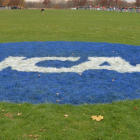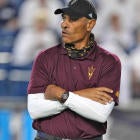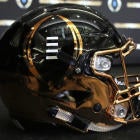Only the five wealthiest conferences could debate what a day off means for their employees ... er, "amateur" athletes. Before the Power Five passed some sensible rules Friday to loosen up athletes' time a little bit, some amendments were proposed by the adults.
USA Today reported one amendment, which overwhelmingly failed, would have allowed athletes to host a recruit on their day off provided they gave prior consent. Another amendment, which closely passed, allows life-skill activities to be held on athletes' off days. Some player representatives at the NCAA Convention weren't buying the amendments, recognizing how the system was trying to control days off for unpaid players who are supposedly students first.
Brady Bramlett, athlete from Ole Miss baseball, urging all these amendments should be voted down to "maintain integrity of the day off"
— Dan Wolken (@DanWolken) January 20, 2017
"It's about owning your time," former Oklahoma football player Ty Darlington said, according to a story on NCAA.org. "Coaches need to understand that student-athletes aren't on call at all times. This is about changing the perception of coaches: Our time is our time."
While learning life skills is great, the amendments symbolized college sports: Propose minutiae to control athletes' time while simultaneously legislating them more freedom. There were some positive rules adopted Friday by the Power Five:
- No athletic activities other than competition (and associated activities) over an eight-hour overnight period, such as from 9 p.m. until 6 a.m. Medical treatment in that window is still allowed.
- Require a seven-day break without athletic activities after a team's season ends. Athletes will get at least another 14 days off outside of their playing and practice season during the academic year.
- Require schools to develop a time-management plan for each sport outlining team activities. Athletes want clearer schedules without so many last-minute changes by their coaches.
- Require a day off per week for athletes during preseason and vacation periods. The so-called "Jim Harbaugh Rule" now prevents off-campus practice during vacation periods outside the championship season.
What remains untouched: The number of games and when/where they are played. If NCAA members really want to make athletes closer to traditional students, play fewer 9 p.m. games on a Tuesday night a couple hours away from your campus. But that won't happen because this is pro sports masked as amateur.
"We all know games are the elephant in the room, especially basketball," said one Power Five athletic director, who asked to remain anonymous.
"I agree it's an issue," Pac-12 commissioner Larry Scott said. "I think that's a more complex, sport-by-sport set of discussions we may have in the future. I think in this first round of time demands legislation we're focusing around the practice schedules."
"You mean we should be the adults in the room and play fewer games?" quipped another anonymous Power Five AD. "We can try to make amends where we can that helps. But the travel for all the games really is what changes their lives. The games seem to be sacred among the athletes."
That's true. Competitors want to compete. They're not going to advocate for fewer games. According to a recent NCAA survey, a majority of athletes don't support eliminating nonconference, mid-week games.
The highest level of support for fewer mid-week nonconference games: women's volleyball (57 percent), women's tennis (52 percent) and field hockey (52 percent). The lowest support: skiing (17 percent), baseball (24 percent), men's basketball (28 percent), men's and women's golf (29 percent each), bowling (29 percent) and women's basketball (32 percent).
Administrators are just as lukewarm at reducing games. Just 35 percent of athletic directors favor the concept. They know what games mean -- especially conference games, not the nonconference games asked about in the NCAA survey. Who's going to turn down TV money from the networks?
There is one group in college sports that really wants fewer games. In the NCAA survey, 71 percent of faculty athletic representatives supported fewer mid-week nonconference games.
This elephant in the room has been building -- and ignored -- for years as conferences got bigger and grew more national. The SEC, Pac-12 and Big Ten have their own television networks. The ACC is getting one soon. Texas has a network. There is inventory to be concerned about to fill these networks.
Maryland is now in the same Big Ten as Nebraska. West Virginia plays Big 12 games in Texas. Florida competes in the SEC with Missouri. The Pac-12 goes all the way east to Colorado. The ACC spreads from Syracuse to Miami north to south and goes west to Louisville and Notre Dame.
Consider the Maryland men's basketball team. In 1996-97, the Terrapins played eight ACC road games (four mid-week) at an average distance of 426 miles. This year, they're playing nine Big Ten road games (five mid-week) at an average distance of 637 miles.
Given the rigorous schedules for athletes -- games, travel, practices, film work, meetings, walkthroughs, weightlifting, off-season workouts, medical treatment, and now even the allowance of life-skill activities on off days -- it's very difficult for some athletes to receive a real education. Many of them have schedules resembling professional athletes.
Enter Seth Berger, the boys basketball coach at The Westtown (Pa.) School, which has sent 10 players to Division I basketball teams in the past 10 years. Berger has a radical idea: Allow NCAA athletes to compete as part-time students.
Athletes typically take 12 credit hours each semester to be eligible as full-time students. Berger suggests cutting that course load in half for eligibility. For every year the athlete plays and carries a partial load, the athlete gets a half-year on a full scholarship to be a full-time student. This means a four-year athlete would get two extra years to complete his or her degree.
The athlete could decide his or her course load and how long to stay in college. By taking half a load, the athlete could find better balance between academics and athletics.
"I'm sure some people would think that idea is ridiculous, but that's because they don't walk in the athletes' shoes," said one Power Five AD who read about Berger's idea. "That would be a useful conversation to have from the academic perspective."
If the NCAA truly believes that academics and athletics can co-exist in a multibillion dollar industry that entertains the masses, then outside-the-box ideas like Berger's must be considered.
Because we know the elephant in the room isn't going to truly be unleashed. The games are too popular and the inventory is too valuable to cut back. The players won't push back because who doesn't love playing games, even if they're detrimental to their education?
The Power Five made some positive changes at the fringes and kept ignoring the elephant. After all, the show must go on.





















